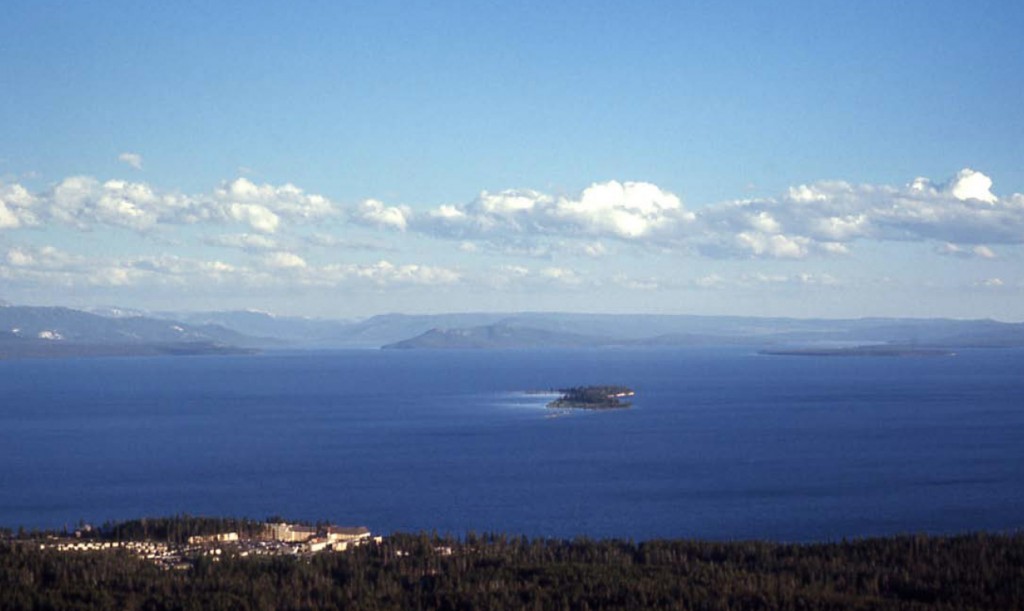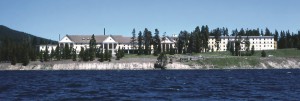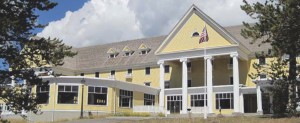
Lake Hotel, lower left, is dwarfed by the expanse of Yellowstone Lake and the surrounding mountains of Yellowstone National Park. (NPS photo - click to enlarge)
From Staff Reports
CODY, WYO. — The National Park Service has approved a modified version of the preferred alternative proposed by Yellowstone Park managers for long-term development and management of the Lake area.
A finding of “no significant impact” for the plan was signed April 17 by the National Park Service Intermountain Region Director. An environmental assessment that analyzed three alternatives for guiding development around Lake Village, Fishing Bridge and Bridge Bay was released for public review and comment in February 2012.
In response to public comments, the National Park Service selected the preferred alternative, with modifications, including a reduction in sites and in the paved area originally proposed for the Fishing Bridge RV park. The plan takes a zoning approach to limiting the development footprint, setting design standards and outlining infrastructure projects.
Among the projects addressed are replacement of 70-year-old water lines, seismic stabilization for Lake Hotel and adaptive use of some historic structures.
“This plan may be different than some in the past,” lead planner Alicia Murphy told a small gathering at a February meeting in Cody.

Lake Hotel, as seen from Yellowstone Lake, is the oldest standing hotel in Yellowstone National Park. (NPS photo - click to enlarge)
Comprehensive plans include design standards, zoning and other elements that haven’t always been a part of environmental reviews of developed areas in Yellowstone, she said. The Tower-Roosevelt area was the first in the park to undergo a comprehensive plan, while Old Faithful, Mammoth Hot Springs and Lake are in that process now.
The idea is to consider a wide range of factors and potential future possibilities and changes over a relatively broad developed area, said Eleanor Clark, chief of comprehensive planning for Yellowstone. As environmental factors or visitor use patterns change, the plan should give managers options for addressing those changes.
The 700-acre planning area hugs the northern shoreline of Yellowstone Lake and covers six distinct zones: Fishing Bridge, an administrative area at Lake, Lake Lodge, Lake Hotel, the lakeshore itself and Bridge Bay and its marina.
The iconic yellow Lake Hotel takes center stage in the minds of many frequent Lake area visitors.

Built in 1891 and expanded and remodeled in 1903, Lake Hotel is the oldest standing hotel in Yellowstone National Park. (NPS photo - click to enlarge)
Built in 1889 by the Northern Pacific Railroad as a plain, clapboard structure, Lake Hotel is the oldest surviving hotel in any national park. It was expanded and remodeled in 1903 by architect Robert Reamer, who also designed the Old Faithful Inn built that same year. Reamer added large porticoes supported by ionic columns, transforming Lake Hotel into a Colonial Revival landmark.
Murphy said in February that some cabins would be moved away from Lodge Creek, where planners are hoping cutthroat trout will be spawning in increasing numbers as efforts continue to reduce predatory lake trout numbers.
Planning documents do not include cost estimates or funding details. Improvements and capital construction are expected to occur over the next 10-15 years as specific funding becomes available from a variety of public and private sources.
Contact Ruffin Prevost at 307-213-9818 or ruffin@yellowstonegate.com.
